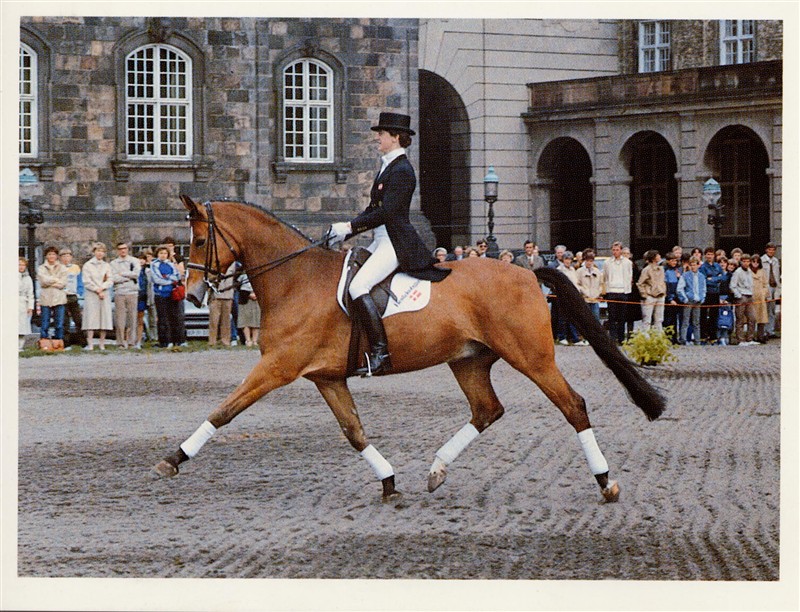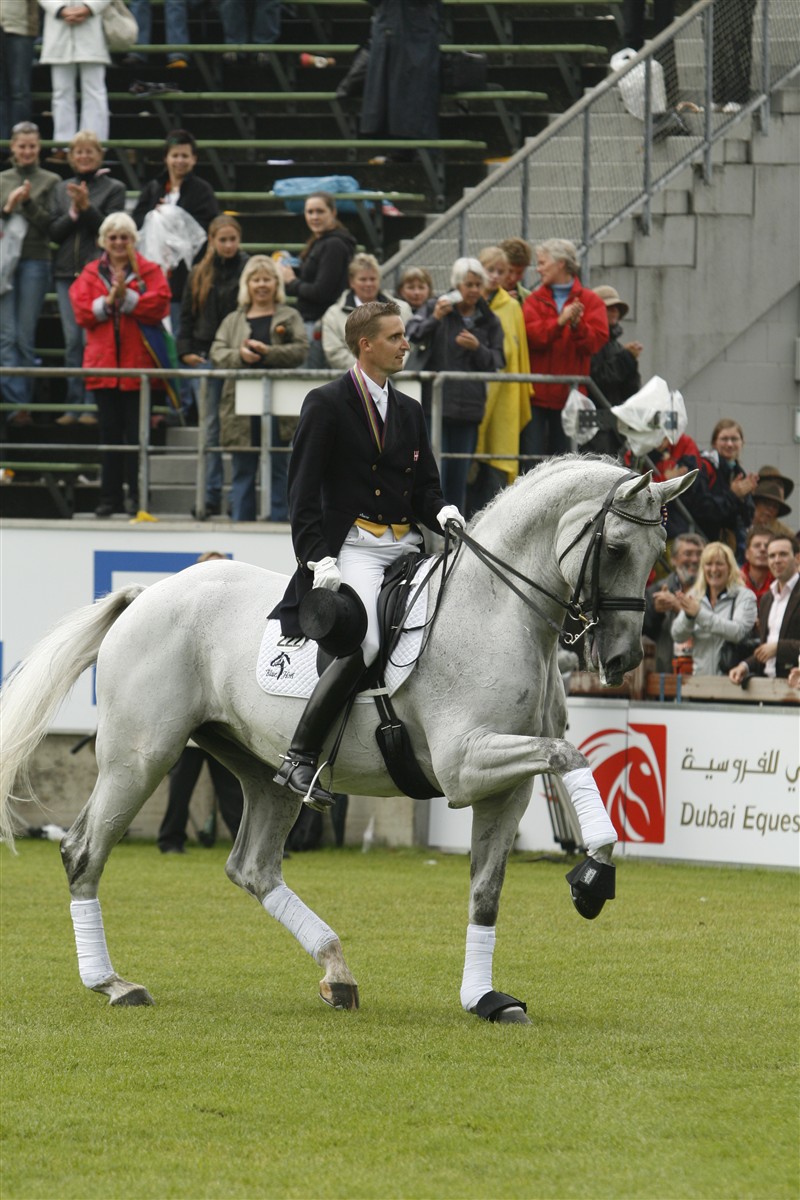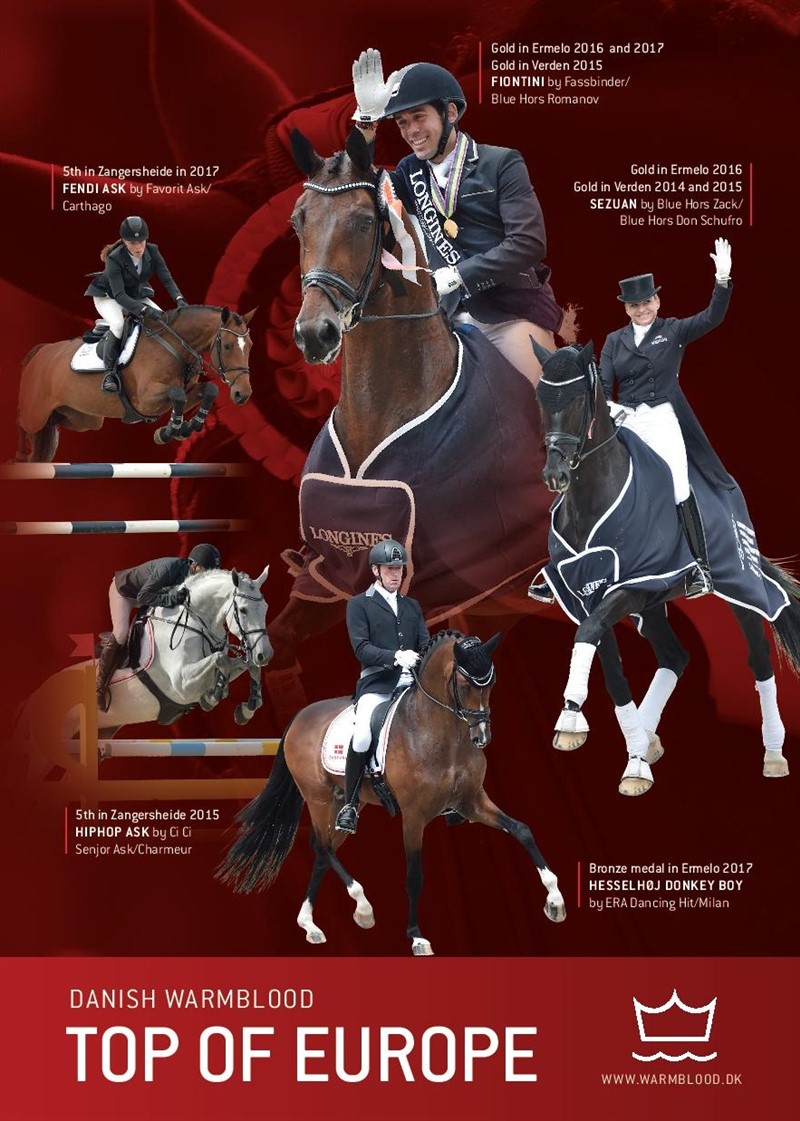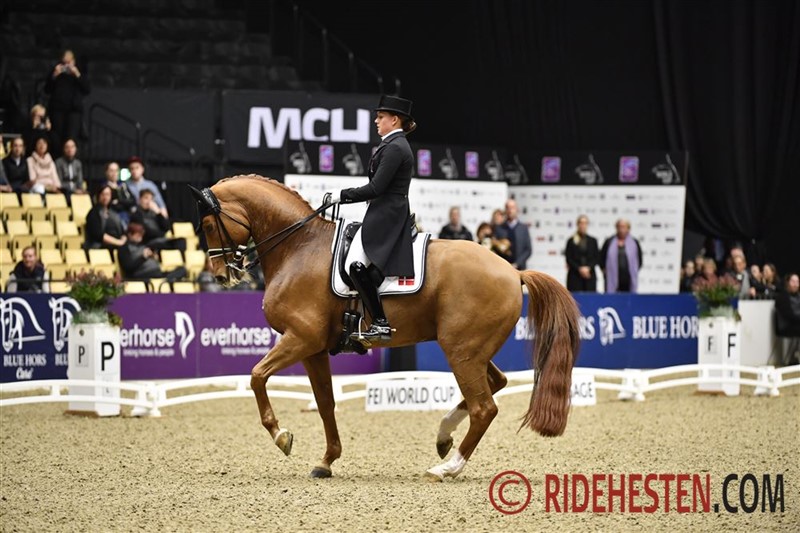What is Dansk Varmblod?
Here you will both find a summary of the Danish Warmblood background, and further below a time line with many more details.

In 1962 the first Danish Sporthorse Breed Society was founded, called Dansk Sportsheste Avlsforbund (DSA). By the end of the 70'ies DSA and another sport horse society, called Danmarks Lette Hesteavl, merged. During 1980 the new name of the merged associations was launched: Dansk Varmblod, known abroad as Danish Warmblood.
Back in 1962 where the mare studbook was established, 150 mares were entered. Only 22 of these were born in Denmark and they were primarily of Oldenburg pedigree. 108 of the mares were of German bloodlines. At that time no register was kept with performance results, but of course horses and riders who had winnings internationally, were noticed. Therefore Lis Hartel and her gelding, Jubilee, are still proudly remembered.
The brand, the Crown over the Wave, was drawn by I. C. Christensen and designed by the Georg Jensen silver smithy in 1963. The logo symbolizes a kingdom surrounded by water.

Anne Grethe Törnblad and Marzog, Dressage Horse of the CenturyIn January 1979 Danish Warmblood held the first stallion grading in the small town of Naestved in a harsh blizzard.
The year 1983 was also memorable, since Anne Grethe Jensen (now Törnblad) and her Danish Warmblood gelding, Marzog won the European Dressage Championship and the Danish dressage team got silver. This made the Danish breeders the second best dressage producing breeders in the world.
In 1986 Her Royal Highness Princess Benedikte became Patroness of Dansk Varmblod. At that occasion Ole Holm, the then chairman presented her with her birthday present from the society: The black warmblood main studbook mare, Øxenholm Pamina by Sandro, who is still to be found in the pedigree of many of the horses born with HRH Princess Benedikte.

Andreas Helgstrand og Blue Hors MatineThe present chairman of Dansk Varmblod, Mr. Jan Pedersen, was elected in 1994, and in 1999 he was elected for president of the World Breeding Federation for Sport Horses (WBFSH), a world-wide organisation of sport horse breed societies.
In 1998, Dansk Varmblod started to proclaim "Stallion of the Year" at the National Stallion Show held each year in March.
In 1999 by an international committee containing dressage judges, Marzog was awarded Dressage Horse of the Century.
At the jumping arenas Dansk Varmblod has also had its triumphs, for instance at the Olympic Games 2000 in Sydney, where the breedsire Lando took silver with his rider, Albert Voorn.
In 2006, Blue Hors Matiné and Andreas Helgstrand were the rising star of the dressage scene at the WEG in Aachen, where they won silver and bronze.
Their fantastic freestyle was seen more than 10 million viewers on Youtube.
In 2008 a new era arose, since DWB started to be in the medals at the World Breeding Championships for Young Dressage horses:
At the World Breeding Dressage championships in Verden 2008, the graceful gold medal mare, Polka Hit Nexen won silver among the 6-year-olds, in 2009 the gelding, Hønnerups Driver, won the class for 5-year-olds while the gold medal mare UNO Donna Unique took silver, and in 2010, the runner-up from 2009, UNO Donna Unique won among the 6-year-olds, again with her rider, Andreas Helgstrand.
2010 was also the year where Mistral Højris ridden by English Laura Bechtolsheimer took 3 x silver at the dressage discipline at WEG in the US.

Again in 2014 a Danish Warmblood horse won a gold medal at the WBCYH in Verden; The 5-year-old breeding stallion Sezuan.
In 2015 Sezuan won as 6-year-old, and the two embryo transfer full sisters Fiontini and Fiontina wrote history by taking the gold- and silver medals among the 5-year-old dressage horses.
In 2016 Fiontini repeated her success and won gold among the 6-year-olds, while Sezuan secured himself a hattrick by winning among the 7-year-olds. This was the first time in the history of World Breeding Championships for Young Horses!
Fiontini could not let Sezuan stand alone with that performance, so as 7-year-old she as the first mare ever got a hattrick as well by winning in Ermelo in 2017 among the 7-year-olds. Among the 5-year-olds, the breeding stallion Hesselhøj Donkey Boy got a bronze medal.
The history of Danish Warmblood
The development of the association Dansk Varmblod up through the decades
- 1962 DSA (The Danish Sports horse breeding Association) was founded
- 1963 The logo brand was designed
- 1964 The first mare stud book was published
- 1970 The first performance test for stallions was established in Næstved
- 1972 DSA joins the common studbook administration at the Danish Agricultural Advisory Centre
- 1976 DLH (Danish Light Horse Society) is founded
- 1979 Dansk Varmblod is founded
- 1980 The stud book administration is made electronically in a database
- 1982 Establishment of ability tests for 4-year-old mares and geldings
- 1984 A common system of registration numbers for foals (breedstock) and competition horses is made
- 1985 Scores at selections and not just a written description
- 1987 Breedsires now have to be evaluated several times in their first decade of breeding. Deletion of license can be done if not satisfactory in breeding
- 1989 Annual book of competition results is generated for the first time
- 1990 Station test of mares, breeding evaluations on breedsires and the concept of an "R-mare" is introduced
- 1992 New breeding objective is introduced
- 1994 One-day tests of mares becomes a possibility
- 1996 Saddle grading of mares is introduced
- 1997 Breeding evaluation on mares and the education of breeders are initialized
- 1999 The main office moves to Vilhelmsborg. DWB is recognized by the EU and the new equine passports are introduced. The horse database is on the internet. The WBFSH chooses Jan Pedersen as new president and the working group Interstallion is founded. HRH Princess Benedikte becomes patroness of WBFSH
- 2000 Karina Christiansen is the new breeding advisor. The performance test is supplemented by a 30-day test. Dansk Varmblod hires their own professional trainer/station test manager.
- 2001 Dansk Sports- og Avlschampionat (Danish Breeding Championships) is introduced
- 2002 The ueln (unique equine life number system) is introduced in the DWB. 8 scores at the exterior evaluation is expanded into 10 scores.
- 2003 The separation of disciplines at the ability tests
- 2004 The Breeding Plan towards 2012 with increased focus on the separation of disciplines is initialized
- 2006 The 30-day test and the 70-day test of stallions are succeeded by three performance tests of 10, 35, and 35 days respectively. Competition data is incorporated in the breeding evaluations.
- 2008 The young breedsires must only enter one discipline at their performance test. Mares for exterior evaluation can enter one with freejumping
- 2010 Hotbranding is prohibited in Denmark and chipmarking gets obligatory. Saddle-grading of mares is now parted in either dressage- or jumping discipine, a further supplement to specialization in the breed.

In 2017, Dansk Varmblod was co-organiser of the first World Cup qualifier in MCH Exhibition Center Herning and the audience had the joy of seeing the OG competitor Cathrine Dufour on her DWB gelding Atterupgaard Cassidy winning the GP.- 2012: The 5th breeding plan (2012-2020) is launched.
- 2013: Research project on genomic selection commences.
- 2014: As a supplement to the scores, linear profiling on foals, 2-year-old mares, and mares for grading is introduced.
- 2016: Obligatory DNA-test on foals is introduced to secure optimum verification of the pedigree. For the first time the Danish Warmblood Stallion Show is extended to also include the new giant arena Boxen in Herning. Der afholdes for første gang hingstekåring i Boxen i messecenter Herning.
- 2017: Dansk Varmblod is co-organiser of the first World Cup qualifier in MCH Exhibition Center Herning. We host the WBFSH general assembly in Billund, Denmark. The requirement of an ”R” for mares if they are to become stallion mothers is cancelled and substituted by a larger focus on performance in the mare lines.
- 2018: An app is launched for direct typing in the scores of linear profiling. The 1-judge mare grading is introduced.
- 2019: Obligatory WFFS tests on all stallions for licensing and in connection with entry on annual stallin list.